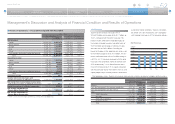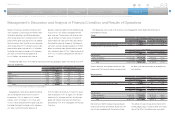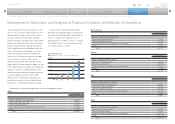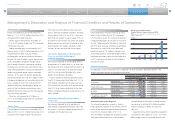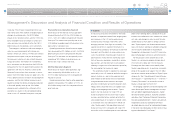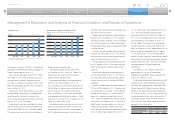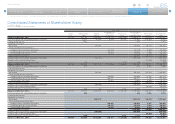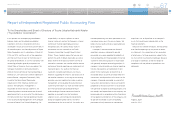Toyota 2014 Annual Report Download - page 61
Download and view the complete annual report
Please find page 61 of the 2014 Toyota annual report below. You can navigate through the pages in the report by either clicking on the pages listed below, or by using the keyword search tool below to find specific information within the annual report.
ANNUAL REPORT 2014
President’s MessagePresident’s Message
Overview of
Four Business Units
Overview of
Four Business Units
Special FeatureSpecial Feature
Review of OperationsReview of Operations
Consolidated Performance
Highlights
Consolidated Performance
Highlights
Management and
Corporate Information
Management and
Corporate Information
Investor InformationInvestor Information
Financial SectionFinancial Section
Page 61
NextPrev
ContentsSearchPrint
Toyota’s unfunded pension liabilities of Japanese
plans decreased during fiscal 2014 by ¥91.0 billion,
or 18.1%, to ¥413.0 billion. The liabilities of foreign
plans also decreased during fiscal 2014 by ¥29.3
billion, or 19.0%, to ¥124.6 billion. The unfunded
amounts will be funded through future cash contri-
butions by Toyota or in some cases will be settled
on the retirement date of each covered employee.
The decrease in unfunded pension liabilities of the
Japanese plans as of the end of fiscal 2014 com-
pared with the prior fiscal year end reflects mainly
an increase in pension assets due to an increase in
equity security prices, despite an increase in pen-
sion benefit obligations that resulted from a decline
in discount rate. The decrease in unfunded pension
liabilities of foreign plans also reflects the increase in
pension assets resulting mainly from an increase in
equity security prices. See note 19 to the consoli-
dated financial statements in Toyota’s annual report
on Form 20-F.
Toyota’s treasury policy is to maintain controls on
all exposures, to adhere to stringent counterparty
credit standards, and to actively monitor market-
place exposures. Toyota remains centralized, and is
pursuing global efficiency of its financial services
operations through Toyota Financial Services
Corporation.
The key element of Toyota’s financial strategy is
maintaining a strong financial position that will allow
Toyota to fund its research and development initia-
tives, capital expenditures and financial services
operations efficiently even if earnings are subject to
short-term fluctuations. Toyota believes that it main-
tains sufficient liquidity for its present requirements
and that by maintaining its high credit ratings, it will
continue to be able to access funds from external
sources in large amounts and at relatively low costs.
Toyota’s ability to maintain its high credit ratings is
subject to a number of factors, some of which are
not within Toyota’s control. These factors include
general economic conditions in Japan and the other
major markets in which Toyota does business, as
well as Toyota’s successful implementation of its
business strategy.
Management’s Discussion and Analysis of Financial Condition and Results of Operations
Selected Financial Summary (U.S. GAAP) Consolidated Segment Information Consolidated Quarterly Financial Summary Management’s Discussion and Analysis of Financial Condition and Results of Operations [14 of 14] Consolidated Financial Statements



